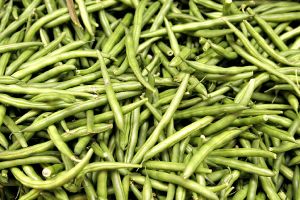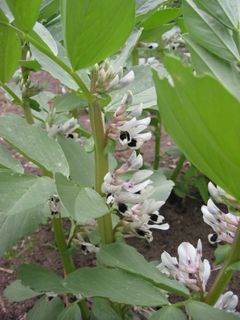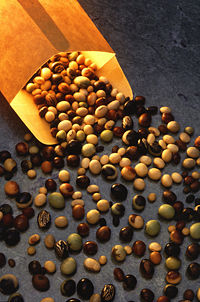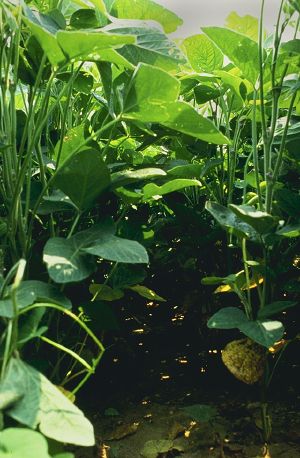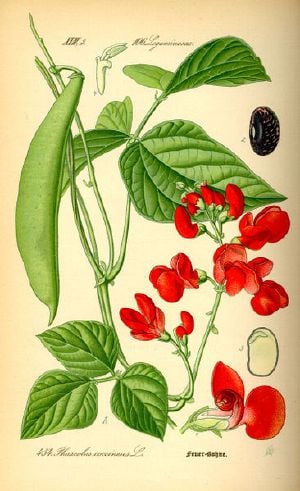Difference between revisions of "Bean" - New World Encyclopedia
| Line 13: | Line 13: | ||
==Old World beans== | ==Old World beans== | ||
| − | In the Old World beans were first cultivated in the [[Middle East]] perhaps around as 10,000 years ago. Along with their fellow legumes the [[pea]] (''Pisum sativum'') and the bitter vetch (''Vicia ervilia''); these were the broad bean (''Vicia faba''), the lentil (''Lens culinaris'') (not always called a bean), the chickpea (''Cicer arietinum''). The soybean (''Glycine max'') was also cultivated very early in [[China]]. | + | In the Old World beans were first cultivated in the [[Middle East]] perhaps around as 10,000 years ago. Along with their fellow legumes the [[pea]] (''Pisum sativum'') and the bitter vetch (''Vicia ervilia''); these were the broad bean (''Vicia faba''), the lentil (''Lens culinaris'') (not always called a bean), the chickpea (''Cicer arietinum''). The soybean (''Glycine max'') was also cultivated very early in [[China]]. Some other Old World beans are cow peas ("Vigna unguiculata"), adzuki (or azuki) beans (''Phaseolus angularis''), and pigeon peas (''Cajanus cajan'') (Walker 2005). |
===Broad beans=== | ===Broad beans=== | ||
| Line 97: | Line 97: | ||
===Common beans=== | ===Common beans=== | ||
| − | The '''common bean''', ''[[Phaseolus]] vulgaris'', indigenous to the [[Americas]], is an [[herb]]aceous [[annual plant]] domesticated independently in ancient [[Mesoamerica]] and the [[Andes]], and now grown worldwide for its edible [[bean]], popular both dry and as a [[green bean]]. The [[leaf]] is occasionally used as a [[leaf vegetable]], and the [[straw]] is used for [[fodder]]. | + | The '''common bean''', ''[[Phaseolus]] vulgaris'', indigenous to the [[Americas]], is an [[herb]]aceous [[annual plant]] domesticated independently in ancient [[Mesoamerica]] and the [[Andes]], and now grown worldwide for its edible [[bean]], popular both dry and as a [[green bean]]. The [[leaf]] is occasionally used as a [[leaf vegetable]], and the [[straw]] is used for [[fodder]]. Along with [[squash]] and [[maize]], beans were the [[Three Sisters (agriculture)|"Three sisters"]] that provided the foundation of [[Native American]] agriculture. |
| − | |||
| − | |||
The common bean is a highly variable species. Bush varieties form erect bushes 20–60 cm tall, while pole or running varieties form [[vine]]s 2–3 m long. All varieties bear alternate, green or purple [[leaf|leaves]], divided into three oval, smooth-edged leaflets, each 6–15 cm long and 3–11 cm wide. The white, pink, or purple [[flower]]s are about 1 cm long, and give way to pods 8–20 cm long, 1–1.5 cm wide, green, yellow, black or purple in color, each containing 4–6 beans. The beans are smooth, plump, kidney-shaped, up to 1.5 cm long, range widely in color, and are often mottled in two or more colors. | The common bean is a highly variable species. Bush varieties form erect bushes 20–60 cm tall, while pole or running varieties form [[vine]]s 2–3 m long. All varieties bear alternate, green or purple [[leaf|leaves]], divided into three oval, smooth-edged leaflets, each 6–15 cm long and 3–11 cm wide. The white, pink, or purple [[flower]]s are about 1 cm long, and give way to pods 8–20 cm long, 1–1.5 cm wide, green, yellow, black or purple in color, each containing 4–6 beans. The beans are smooth, plump, kidney-shaped, up to 1.5 cm long, range widely in color, and are often mottled in two or more colors. | ||
| − | |||
| − | |||
| − | |||
| − | |||
| − | |||
| − | |||
| − | |||
| − | |||
| − | |||
Before they are eaten, the raw bean seeds should be boiled for at least ten minutes to degrade a [[toxin|toxic]] compound - the [[lectin]] [[phytohaemagglutinin]] - found in the bean which would otherwise cause severe gastric upset. This compound is present in many varieties (and in some other species of bean), but is especially concentrated in red kidney beans. Although in the case of dry beans the ten minutes required to degrade the toxin is much shorter than the hours required to fully cook the beans themselves, outbreaks of poisoning have been associated with the use of [[slow cooker]]s whose low cooking temperatures may be unable to degrade the toxin. [[Sprouts]] of [[pulses]] high in haemaglutins should not be eaten. Red kidney beans, especially, should not be sprouted. | Before they are eaten, the raw bean seeds should be boiled for at least ten minutes to degrade a [[toxin|toxic]] compound - the [[lectin]] [[phytohaemagglutinin]] - found in the bean which would otherwise cause severe gastric upset. This compound is present in many varieties (and in some other species of bean), but is especially concentrated in red kidney beans. Although in the case of dry beans the ten minutes required to degrade the toxin is much shorter than the hours required to fully cook the beans themselves, outbreaks of poisoning have been associated with the use of [[slow cooker]]s whose low cooking temperatures may be unable to degrade the toxin. [[Sprouts]] of [[pulses]] high in haemaglutins should not be eaten. Red kidney beans, especially, should not be sprouted. | ||
| − | |||
Similar to other beans, the common bean is high in [[starch]], [[protein]] and [[dietary fiber]] and an excellent source of [[iron]], [[potassium]], [[selenium]], [[molybdenum]], [[thiamine]], [[vitamin B6]], and [[folic acid]]. | Similar to other beans, the common bean is high in [[starch]], [[protein]] and [[dietary fiber]] and an excellent source of [[iron]], [[potassium]], [[selenium]], [[molybdenum]], [[thiamine]], [[vitamin B6]], and [[folic acid]]. | ||
| − | |||
| − | |||
| − | |||
| − | |||
| − | |||
| − | |||
| − | |||
| − | |||
| − | |||
| − | |||
| − | |||
| − | |||
| − | |||
| − | |||
| − | |||
| − | |||
| − | |||
| − | |||
| − | |||
| − | |||
===Lima beans=== | ===Lima beans=== | ||
| Line 144: | Line 112: | ||
The '''Lima bean''' or '''butter bean''' or '''Liam and Alec''' (''[[Phaseolus]] lunatus'', [[Fabaceae]]) is grown as a [[vegetable]] for its mature and immature [[bean]]s. Also known as '''Haba bean''', '''Burma bean''', '''Guffin bean''', '''Hibbert bean''', '''Java bean''', '''Sieva bean''', '''Rangood bean''', '''Madagascar bean''', '''Paiga''', '''Paigya''', '''Prolific bean''', '''Civet bean''' and '''Sugar bean''' | The '''Lima bean''' or '''butter bean''' or '''Liam and Alec''' (''[[Phaseolus]] lunatus'', [[Fabaceae]]) is grown as a [[vegetable]] for its mature and immature [[bean]]s. Also known as '''Haba bean''', '''Burma bean''', '''Guffin bean''', '''Hibbert bean''', '''Java bean''', '''Sieva bean''', '''Rangood bean''', '''Madagascar bean''', '''Paiga''', '''Paigya''', '''Prolific bean''', '''Civet bean''' and '''Sugar bean''' | ||
| − | The lima bean is of [[Andes|Andean]] and [[Mesoamerica]]n origin. Two separate [[domestication]] events are believed to have occurred. The first, taking place in the Andes around 6500 B.C.E., produced a large-seeded variety (Lima type), while the second, taking place most likely in Mesoamerica around 800 C.E., produced a small-seeded variety (Sieva type). By | + | The lima bean is of [[Andes|Andean]] and [[Mesoamerica]]n origin. Two separate [[domestication]] events are believed to have occurred. The first, taking place in the Andes around 6500 B.C.E., produced a large-seeded variety (Lima type), while the second, taking place most likely in Mesoamerica around 800 C.E., produced a small-seeded variety (Sieva type). By around 1300 AD, cultivation spread to [[North America]]. |
The small-seeded wild form (Sieva type) is found distributed from [[Mexico]] to [[Argentina]], generally below 1600 meters above sea level, while the large-seeded wild form (Lima type) is found distributed in [[Ecuador]] and the north of [[Peru]], between 320 and 2030 meters above sea level. | The small-seeded wild form (Sieva type) is found distributed from [[Mexico]] to [[Argentina]], generally below 1600 meters above sea level, while the large-seeded wild form (Lima type) is found distributed in [[Ecuador]] and the north of [[Peru]], between 320 and 2030 meters above sea level. | ||
Both bush and pole ([[vine]]) varieties exist, the latter from one to four meters in height. The bush varieties mature earlier than the pole varieties. The pods are up to 15 cm long. The mature seeds are 1 to 3 cm long and oval to kidney shaped. In most varieties the seeds are quite flat, but in the "potato" varieties the shape approaches spherical. White seeds are common, but black, red, orange and variously mottled seeds are also known. The immature seeds are uniformly green. | Both bush and pole ([[vine]]) varieties exist, the latter from one to four meters in height. The bush varieties mature earlier than the pole varieties. The pods are up to 15 cm long. The mature seeds are 1 to 3 cm long and oval to kidney shaped. In most varieties the seeds are quite flat, but in the "potato" varieties the shape approaches spherical. White seeds are common, but black, red, orange and variously mottled seeds are also known. The immature seeds are uniformly green. | ||
| − | |||
| − | |||
===Runner beans=== | ===Runner beans=== | ||
Revision as of 20:55, 5 August 2006
Bean is a common name for large plant seeds of several members of the Legume family (Fabaceae, formerly Leguminosae) used for food or feed. The various species of bean plants include some of the very first plants cultivated by man in both the Old and the New Worlds. They have been and continue to be an important part of the human food supply, providing protein, vitamins, and other nutrients.
Name
"Bean" originally meant the seed of the broad bean, but was later broadened to include members of the genus Phaseolus such as the common bean and the runner bean and the related genus Vigna. The term is now applied in a general way to many other related plants such as soybeans, peas, lentils, vetches and lupines.
"Bean" can be used as a near synonym of "pulse", an edible legume, though the term "pulses" is usually reserved for leguminous crops harvested for their dry grain. Pulses usually excludes crops mainly used for oil extraction (like soybean and peanut) or those used exclusively for forage (like clover and alfalfa). Leguminous crops harvested green for food like snap beans, green peas etc. are classified as vegetable crops.
In English usage beans sometimes also refer to seeds or other organs of non leguminosae, for example coffee beans, castor beans and cocoa beans (which resemble bean seeds), and vanilla beans (which resemble the pods).
Old World beans
In the Old World beans were first cultivated in the Middle East perhaps around as 10,000 years ago. Along with their fellow legumes the pea (Pisum sativum) and the bitter vetch (Vicia ervilia); these were the broad bean (Vicia faba), the lentil (Lens culinaris) (not always called a bean), the chickpea (Cicer arietinum). The soybean (Glycine max) was also cultivated very early in China. Some other Old World beans are cow peas ("Vigna unguiculata"), adzuki (or azuki) beans (Phaseolus angularis), and pigeon peas (Cajanus cajan) (Walker 2005).
Broad beans
Vicia faba, the broad bean, fava bean, faba bean, horse bean, field bean or tic bean is native to north Africa and southwest Asia, and extensively cultivated elsewhere. Although usually classified in the same genus Vicia as the vetches, some botanists treat it in a separate monotypic genus as Faba sativa Moench.
The broad bean plant is upright 0.5-1.7 meters (2-5 feet) tall, with stout stems with a square cross-section. The leaves are 10-25 cm (4-10 inches) long with 2-7 leaflets, and of a gray-green color. Unlike most other vetches, the leaves do not have tendrils for climbing over other vegetation. The flowers are 1-2.5 cm (0.4-1 inches) long, with five petals, the standard petal white, the wing petals white with a black spot, and the keel petals white. The fruit is a broad leathery pod, green maturing blackish-brown, with a densely downy surface. In the wild species, the pods are 5-10 cm (2-4 inches) long and 1 cm (0.4 inches) diameter, but many modern cultivars developed for food use have pods 15-25 cm long (6-10 inches) and 2-3 cm (about an inch) thick. Each pod contains 3-8 seeds; round to oval and 5-10 mm (0.2-0.4 inches) in diameter in the wild plant, usually flattened and up to 20-25 mm (0.8-1.2 inches) long, 15 mm (0.6 inches) broad and 5-10 mm (0.2-0.4 inches) thick in food cultivars.
Broad beans require a cool season to develop best and in some places are sown in fall as a winter crop and harvested in spring.
Broad beans were an important crop throughout ancient and Medieval times. In ancient Rome they began to be cultivated to feed livestock as well as for humans. In recent times they have become less important as a human food and are mainly grown for animal feed. China is the largest grower today producing about 60% of the world's supply. Europe and North Africa are also centers of broad bean cultivation (Muehlbauer 1997).
Lentils
The lentil (Lens culinaris) is a brushy annual plant about 40 cm (16 inches) tall. Its seeds are lens-shaped (from which comes the word "lens"). They grow in pods, usually with two seeds in each. With 25% protein it is the vegetable with the highest level of protein other than soybeans, and because of this it is a very important part of the diet in many parts of the world, and especially South Asia which has a large vegetarian population.
A variety of lentils exist with colors that range from yellow to red-orange to green, brown and black. The colours of the seeds when removed from the pods also vary, and there are large and small varieties. They are sold in many forms, with or without the pods, whole or split.
In South Asia, lentils are known as dal, as are most sorts of dried legumes. The dishes made predominantly of lentils are also known as dal.
Lentils are relatively tolerant to drought and are grown throughout the world. About half of the worldwide production of lentils is from India, most of which is consumed in the domestic market.
A famous variety of small green lentils known for their earthy flavor is grown in Le Puy, France. These Le Puy lentils (lentilles du Puy) were the first dry vegetable protected by the French AOC (Appelation d'Origine Controlée) designation.
Chickpeas
The chickpea, chick pea, garbanzo bean, ceci bean, bengal gram, chana or channa (Cicer arietinum)
The plant is 20-50 cm (8-20 inches) to high and has small feathery leaves on both sides of the stem. One seedpod contains two or three peas. The flowers are white- or reddish-blue. Chickpeas need a subtropical or tropical climate and more than 400 mm annual rain. They can be grown in a temperate climate, but yields will be much lower.
The chickpea is grown in the Mediterranean, western Asia and India. The wild ancestor of domesticated chickpeas is Cicer reticulatum. As this only grows in southeast Turkey, this is the most likely locus of domestication.
Soybeans
The Soybean (U.S.) or Soya bean (UK) (Glycine max) is a species of legume, native to eastern Asia. It is an annual plant, which may vary in growth habit and height. It may grow prostrate, not growing above 20 cm (7.8 inches); up to stiffly erect plants growing to 2 meters (6.5 feet). The pods, stems, and leaves are covered with fine brown or gray pubescence. The leaves are trifoliate (sometimes with 5 leaflets), the leaflets 6-15 cm (2-6 inches) long and 2-7 cm (1-3 inches) broad; they fall before the seeds are mature. The small, inconspicuous, self-fertile flowers are borne in the axil of the leaf and are either white or purple; The fruit is a hairy pod that grow in clusters of 3-5, with each pod 3-8 cm (1-3 inches) long and usually containing 2-4 (rarely more) seeds 5-11 mm in diameter.
Like corn and some other crops of long domestication, the relationship of the modern soybean to wild-growing species can no longer be traced with any degree of certainty. It is a cultural variety (a cultigen) with a very large number of cultivars. However, it is known that the progenitor of the modern soybean was a vine-like plant, that grew prone on the ground.
Soybeans are an important global crop. It is grown for its oil and protein. The bulk of the crop is solvent extracted for vegetable oil and the defatted soy meal is used for animal feed. A very small proportion of the crop is consumed directly for food by humans. Soybean products, however, appear in a large variety of processed foods.
Soybeans have been a crucial crop in eastern Asia since long before written records, and they are still a major crop in China, Korea, and Japan today. Soybeans were first introduced to Europe in the early 1700s and the United States in 1765, where it was first grown for hay. Benjamin Franklin wrote a letter in 1770 mentioning sending soybeans home from England. Soybeans did not become an important crop outside of Asia until about 1910.
Cultivation is successful in climates with hot summers, with optimum growing conditions in mean temperatures of 20 °C to 30 °C (68°F to 86°F); temperatures of below 20 °C and over 40 °C (68 °F, 104 °F) retard growth significantly. They can grow in a wide range of soils, with optimum growth in moist alluvial soils with a good organic content.
Soybeans are native to southeast Asia, but 45 percent of the world's soybean area, and 55 percent of production, is in the United States. The U.S. produced 75 million metric tons of soybeans in 2000, of which more than one-third was exported. Other leading producers are Brazil, Argentina, China, and India.
Soybeans can be broadly classified as "vegetable" (garden) or field (oil) types. Vegetable types cook more easily, have a mild nutty flavor, better texture, are larger in size, higher in protein, and lower in oil than field types. Tofu and soymilk producers prefer the higher protein cultivars bred from vegetable soybeans originally brought to the United States in the late 1930s. The "garden" cultivars are generally not suitable for mechanical combine harvesting because they have a tendency for the pods to shatter on reaching maturity.
Among the legumes, the soybean, also classed as an oilseed, is pre-eminent for its high (38-45%) protein content as well as its high (20%) oil content. Soybeans are the leading agricultural export in the United States. The bulk of the soybean crop is grown for oil production, with the high-protein defatted and "toasted" soy meal used as livestock feed. A smaller percentage of soybeans are used directly for human consumption.
Soybeans may be boiled whole in their green pod and served with salt, under the Japanese name edamame. Soybeans prepared this way are a popular local snack in Hawai'i, where, as in China, Japan, and Korea the bean and products made from the bean (miso, natto, tofu, douchi, doenjang, ganjang and others) are a popular part of the diet.
The beans can be processed in a variety of ways. Common forms of soy (or soya) include soy meal, soy flour, "soy milk", tofu, textured vegetable protein (TVP, which is made into a wide variety of vegetarian foods, some of them intended to imitate meat), tempeh, soy lecithin and soybean oil. Soybeans are also the primary ingredient involved in the production of soy sauce (or shoyu).
In the 2002-2003 growing season, 30.6 million metric tons of soybean oil were produced worldwide, constituting about half of worldwide edible vegetable oil production, and thirty percent of all fats and oils produced, including animal fats and oils derived from tropical plants.[1]
Soybean meal, the material remaining after solvent extraction of soybean flakes, with a 50% soy protein content, toasted (a misnomer because the heat treatment is with moist steam), and ground, in a hammer mill, provided the energy for the American revolution, beginning in the 1930s, of growing farm animals such as poultry and swine on an industrial scale; and more recently the aquaculture of catfish.
Soy flour refers to defatted soybeans where special care was taken during desolventizing (not toasted) in order to minimize denaturation of the protein to retain a high Nitrogen Solubility Index (NSI), for uses such as extruder texturizing (TVP). It is the starting material for production of soy concentrate and soy protein isolate.
Infant formulas based on soy are used by lactose-intolerant babies; and for babies that are allergic to human milk proteins and cow milk proteins. The formulas are sold in powdered, ready to feed, or concentrated liquid forms.
It has been recomended internationally by pediactric associations that soy formulas not be used as the primary or sole source of nutrition for infants due to the high risk of several deficiencies including calcium and zinc.
Many traditional dairy products have been imitated using processed soybeans, and imitation products such as "soy milk," "soy yogurt" and "soy cream cheese" are readily available in most supermarkets. These imitation products are derived from extensive processing to produce a texture and appearance similar to the real dairy-based ones. Soy milk does not contain significant amounts of calcium, since the high calcium content of soybeans is bound to the insoluble constituents and remains in the pulp. Many manufacturers of soy milk now sell calcium-enriched products as well.
Soybeans are also used in industrial products including oils, soap, cosmetics, resins, plastics, inks, crayons, solvents, and biodiesel. Soybeans are also used as fermenting stock to make a brand of vodka.
Henry Ford promoted the soybean, helping to develop uses for it both in food and in industrial products, even demonstrating auto body panels made of soy-based plastics. Ford's interest lead to 2 bushels of soybeans being used in each Ford car as well as products like the first commercial soy milk, ice cream and all-vegetable non-dairy whipped topping.
The Ford development of so called soy-based plastics was based on the addition of soybean flour and wood flour to phenolformaldehyde plastics.
Today, very high quality textile fibers are made commercially from okara or soy pulp, a by- product of tofu production.
New World beans
Common beans
The common bean, Phaseolus vulgaris, indigenous to the Americas, is an herbaceous annual plant domesticated independently in ancient Mesoamerica and the Andes, and now grown worldwide for its edible bean, popular both dry and as a green bean. The leaf is occasionally used as a leaf vegetable, and the straw is used for fodder. Along with squash and maize, beans were the "Three sisters" that provided the foundation of Native American agriculture.
The common bean is a highly variable species. Bush varieties form erect bushes 20–60 cm tall, while pole or running varieties form vines 2–3 m long. All varieties bear alternate, green or purple leaves, divided into three oval, smooth-edged leaflets, each 6–15 cm long and 3–11 cm wide. The white, pink, or purple flowers are about 1 cm long, and give way to pods 8–20 cm long, 1–1.5 cm wide, green, yellow, black or purple in color, each containing 4–6 beans. The beans are smooth, plump, kidney-shaped, up to 1.5 cm long, range widely in color, and are often mottled in two or more colors.
Before they are eaten, the raw bean seeds should be boiled for at least ten minutes to degrade a toxic compound - the lectin phytohaemagglutinin - found in the bean which would otherwise cause severe gastric upset. This compound is present in many varieties (and in some other species of bean), but is especially concentrated in red kidney beans. Although in the case of dry beans the ten minutes required to degrade the toxin is much shorter than the hours required to fully cook the beans themselves, outbreaks of poisoning have been associated with the use of slow cookers whose low cooking temperatures may be unable to degrade the toxin. Sprouts of pulses high in haemaglutins should not be eaten. Red kidney beans, especially, should not be sprouted.
Similar to other beans, the common bean is high in starch, protein and dietary fiber and an excellent source of iron, potassium, selenium, molybdenum, thiamine, vitamin B6, and folic acid.
Lima beans
The Lima bean or butter bean or Liam and Alec (Phaseolus lunatus, Fabaceae) is grown as a vegetable for its mature and immature beans. Also known as Haba bean, Burma bean, Guffin bean, Hibbert bean, Java bean, Sieva bean, Rangood bean, Madagascar bean, Paiga, Paigya, Prolific bean, Civet bean and Sugar bean
The lima bean is of Andean and Mesoamerican origin. Two separate domestication events are believed to have occurred. The first, taking place in the Andes around 6500 B.C.E., produced a large-seeded variety (Lima type), while the second, taking place most likely in Mesoamerica around 800 C.E., produced a small-seeded variety (Sieva type). By around 1300 C.E., cultivation spread to North America.
The small-seeded wild form (Sieva type) is found distributed from Mexico to Argentina, generally below 1600 meters above sea level, while the large-seeded wild form (Lima type) is found distributed in Ecuador and the north of Peru, between 320 and 2030 meters above sea level.
Both bush and pole (vine) varieties exist, the latter from one to four meters in height. The bush varieties mature earlier than the pole varieties. The pods are up to 15 cm long. The mature seeds are 1 to 3 cm long and oval to kidney shaped. In most varieties the seeds are quite flat, but in the "potato" varieties the shape approaches spherical. White seeds are common, but black, red, orange and variously mottled seeds are also known. The immature seeds are uniformly green.
Runner beans
The runner bean (Phaseolus coccineus, Fabaceae) is often called the scarlet runner bean since most varieties have red flowers and multicolored seeds, though some have white flowers and white seeds. It is native to the mountains of Central America.
The runner bean differs from the common bean in several respects: the cotyledons stay in the ground during germination, and the plant is a perennial with tuberous roots (though it is usually treated as an annual).
The green pods are edible whole but in some varieties (the scarlet runner) tend to become fibrous early, and only the seeds within are eaten. The seeds can be used fresh or as dried beans. The starchy roots are still eaten by Central American Indians. The scarlet runner is widely grown for its attractive flowers by people who would never think of eating it.
Phaseolus coccineus subsp. darwinianus is a cultivated subspecies of P. coccineus, it is commonly referred to as the Botil bean in Mexico.
ReferencesISBN links support NWE through referral fees
- Berk, Z., 1992, "Technology of Production of Edible Flours and Protein Products from Soybeans", Food and Agriculture Organization of the United Nation[1]
- Hernández Bermejo, J.E. & León, J., 1992, "Neglected crops: 1492 from a different perspective", Food and Agricultural Organization of the United Nations (FAO)[2]
- Muehlbauer, F.J. & Tullu, A, 1997, "Vicia faba L.", Purdue University[3]
- North Carolina Soybean Producers Association (NCSPA), Website, [4]
- Walker, E. & L., 2005, "Beans (which includes a lot of vegetable species!)", Growingtaste.com[5]
- Watson, R., 2004, "A Closer Look at Legumes", Mediterrasian.com[6]
Credits
New World Encyclopedia writers and editors rewrote and completed the Wikipedia article in accordance with New World Encyclopedia standards. This article abides by terms of the Creative Commons CC-by-sa 3.0 License (CC-by-sa), which may be used and disseminated with proper attribution. Credit is due under the terms of this license that can reference both the New World Encyclopedia contributors and the selfless volunteer contributors of the Wikimedia Foundation. To cite this article click here for a list of acceptable citing formats.The history of earlier contributions by wikipedians is accessible to researchers here:
The history of this article since it was imported to New World Encyclopedia:
Note: Some restrictions may apply to use of individual images which are separately licensed.
- ↑ United States Department of Agriculture, Agricultural Statistics 2004. Table 3-51.
